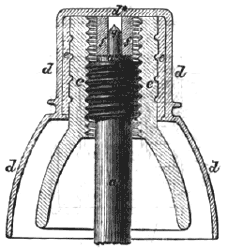[Trade Journal]
Publication: The Telegraphic Journal and Electrical Review
London, England
vol. 7, p. 127-128, col. 2,1
OPPENHEIMER'S LIGHTNING GUARD INSULATOR.
THIS invention is designed to obviate the inconvenience which arises in working telegraph lines from the breakage of insulators by lightning, and a consequent making of earth contact by the conducting wires. In order to avoid this kind of fault, a lightning discharger is introduced in the interior of the insulator, which is provided with a metallic covering.
The accompanying fig. shows a section of the improved insulator.
 |
At a is the metallic insulator pin connected with the post, supported in this case to be of metal, and having formed or attached thereon a screw b which supports the earthenware or other such insulator c, open at the top, as shown in the fig. On the out side of this insulator is a metallic cap d, secured by means of cement e, and to this metallic cap the telegraph line wire is attached in the ordinary manner.
Upon the top a* of the insulator pin is placed a ring fof insulating material, and the distance to which this ring extends determines the distance between the top of d* of the cap and an extended part g of the pin a. This distance may be varied to some extend, but that shown in the fig., which is 1/4 scale, may be taken as the relative standard.
By this arrangement an effective lightning discharger is obtained within the insulator, the lightning passing through the top d* of the cap to the post g, and from thence along the pin a to earth.
In cases where wooden posts are used, the pin a may be connected to earth by means of an earth wire in the usual manner.
